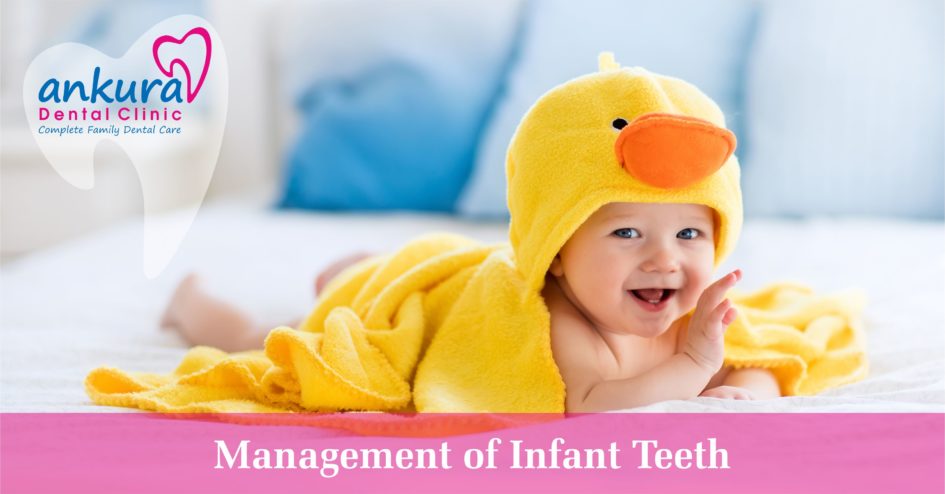What is Natal Tooth?
Any tooth or tooth resembling structure present in oral cavity at time of birth in infants is termed as Natal tooth.
What is Neo-natal Tooth?
Any tooth or tooth resembling structure present in oral cavity within first 30 days of birth in infants is termed as Natal tooth.
However, it must be emphasized that milk teeth (primary teeth) begin to appear from 6 months of age whilst natal and neonatal teeth are commonly extra or supernumerary tooth present in infants.
At Ankura Dental Clinic in addition to various dental specialties we possess that includes orthodontist, implantologist, cosmetic dentist, root canal specialist and oral surgeons, we also have one of the best high profile team of child dentist that deal with all your child oral problems from infancy through adolescence.
Our Pediatric dentist are vastly experienced and well versed with the oral problems your infant can possess.
Other names/synonyms for infant teeth?
Fetal teeth, Congenital teeth, Predeciduous teeth, and Precocious dentition (by Mayhall and Bodenhoff), as well as Dens connatalis and Dentitia praecox have been commonly used to describe these teeth.
How can Natal and Neonatal teeth be diagnosed?
It is advisable to involve a paediatric dentist early in the diagnosis and management of natal/neonatal teeth.
At Ankura Dental Clinic which is one of the best dental clinic in Hyderabad, providing the best infant and child dental care under the expertise of vastly experienced children’s dentist such conditions are instantly detected and managed.
In addition to the advanced specialty dental services we also have modern diagnostic technology that enables us to provide your infant best preventative dental care by detecting oral problems at the earliest stage possible.
Historical Background of Natal and Neonatal teeth?
The misconceptions and folklore surrounding neonatal and natal teeth vary largely in some southeast-Asian communities, a natal tooth is believed to bring good fortune while in others, its occurrence is considered a bad omen. In India, China, Africa and Poland, the affected infants are looked upon as monsters and bearers of misfortune. Strangely in England, the belief was that this condition would guarantee the conquest of the world.
At Ankura Dental Clinic we understand your emotions and concerns and hence we constantly strive to provide you the best dental care available.
Prevalence and associated conditions to be expected with Natal and Neonatal teeth?
The prevalence ranges between 1:700 to 1:30,000, while some european studies has reported 1 in 2000 to 1 in 3500 live births.
The male to female ratio varies in different studies with some reporting a predominance in males to no difference while some show female predominance. In one study on cleft lip/palate babies there was a slight female predominance in those with natal teeth and unilateral cleft lip/palate while marked male predominance in those with natal teeth and bilateral cleft lip/palate.
Natal and neonatal teeth are rarely seen in very premature babies however Natal teeth are said to be three times more common than neonatal teeth.
There has been a strong correlation between natal teeth and Cleft lip/palate with 10% of children with bilateral cleft lip/palate have natal teeth and 2% of unilateral cleft lip/palate presenting natal teeth. Natal teeth can be associated with various syndromes as reported:
- Ellis-van Creveld syndrome
- Jackson-Lawler syndrome
- Steatocystoma multiplex with natal teeth
- Hallerman-Streiff syndrome
It must be highlighted that dental specialist in the field of child dentistry are trained and qualified to assess the associated syndromes. Hence at Ankura Dental Clinic, a comprehensive diagnostic assessment by our team of Pediatric dentist must be done. We are one of the famous dental clinics which has an in-house pediatric and neonatology services to provide the necessary multidisciplinary approach your infant may need.
How are the clinical features of Natal and Neonatal teeth?
The appearance of each natal tooth that emerge in the oral cavity can be classified based on their shape and size into four categories as they emerge.
- Shell-shaped crown poorly fixed to the alveolus by gingival tissue and absence of a root.
- Solid crown poorly fixed to the alveolus by gingival tissue and little or no root.
- Eruption of the incisal margin of the crown through the gingival tissues.
- Edema of gingival tissue with an unerupted but palpable tooth.
In X-ray the subjected tooth will appear as a hollow calcified cap of enamel and dentin without pulp tissue, rather like a celluloid crown in shape. X-rays are helpful in determining whether the tooth is a milk tooth or an extra tooth.
At Ankura Dental Clinic we have advanced state of the art diagnostic equipment to detect and assess your child oral problems. With the advanced digital x-ray machines present at Ankura Dental Clinics such infant teeth can be diagnosed and assessed easily. This helps us in providing your infant the best dental care.
Where can I expect Natal and Neonatal tooth?
Natal and Neonatal teeth can be seen commonly in the following regions in the oral cavity based on the occurrence:
- Lower front gum region
- Upper front gum region
- Lower back gum region
- Upper back gum region
Complication associated with Natal and Neonatal teeth?
Complications to the infant may include dehydration and malnutrition secondary to feeding difficulties leading to low weight and poor growth of infant.
Ulcer formation secondary to trauma to the tip or underneath of the tongue can be seen.
Risk of loss of tooth – which can be swallowed or inhaled by the infant
Pain/distress can be experienced by the infant due to erupting neonatal tooth
Possibility of development of dental decay, as the physical integrity of such tooth is poor.
Tenderness during breast feeding secondary to painful bitten or bleeding nipples are common complications experienced by mothers.
Management of Natal and Neonatal tooth?
At Ankura Dental Clinic, our team of specialized children dentist will customize the best dental treatment tailor-made for your infant following detailed assessment of the risk and complications expected by such tooth.
Our child dental specialist will vary the treatment ranging from a conservative approach by rounding the sharp ends of the tooth to more aggressive and conclusive tooth extraction. However, this is decided after a thorough discussions with the parents and assessment of the associated risks.
Our Pediatric dentist will perform extractions if the natal/neo-natal tooth is found:
- Loose
- Extra or supernumerary tooth
- Associated with cleft lip and palate
At Ankura Dental Clinic we emphasize the importance of conservative dentistry.
Conservative management of natal/neo-natal tooth includes:
- Smoothing sharp edges of the tooth
- Application of composite filling to form a dome shape so the tongue glides over the tooth
- Protective Stomahesive wafers/rings
- Alteration in feeding technique to prevent dental injuries
- Dental hygiene including preventive dental topical fluoride application
NOTE: In case you observe such condition in your infant, please do make an appointment with our child dental specialist at any of our Ankura Dental Clinic located nearest to you.
By
Ankura Dental – Best Dental Clinic in Hyderabad
Tags: Child Dental, Child Dental Specialist, Child Dentistry, Child Oral Problems, Infant Teeth, Management of Infant Teeth, Milk tooth, Natal and Neonatal teeth, Natal teeth, Natal Tooth, Neonatal teeth, Pediatric Dentist, What is Natal Tooth?





Leave a Reply